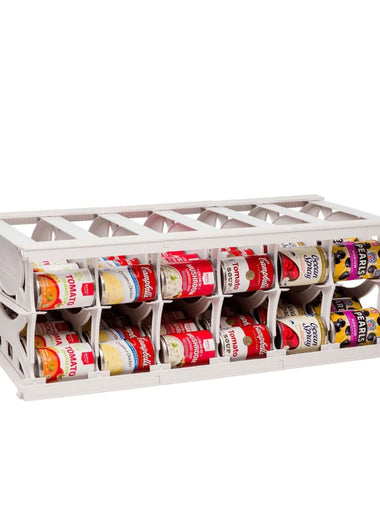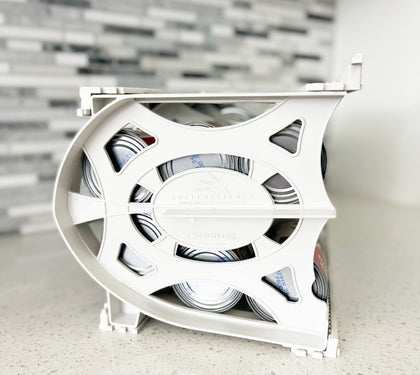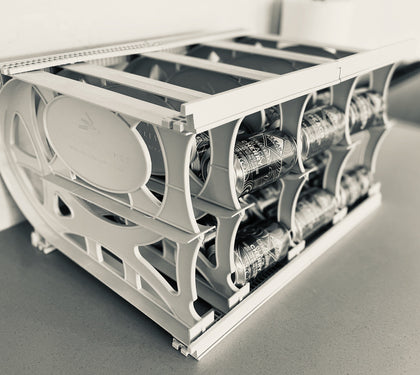Canned food storage has come a long way since its inception in the early 19th century. What first began as a military innovation has now become a staple in households worldwide. In this article, we'll take a brief journey through time to explore the evolution of canned food storage, reviewing the key milestones, innovations, and the people who contributed to this remarkable food storage invention.
The Birth of Canned Food: 1810
- Date: 1810
- Key Figure: Nicolas Appert
- Description: French chef and inventor Nicolas Appert is credited with developing the first method for preserving food in sealed glass jars, which later evolved into modern canning. His breakthrough was awarded a prize of 12,000 francs by the French government.
Early Canning Methods: Early 19th Century
- Date: Early 19th Century
- Innovations: Tin-plated cans replaced glass containers, improving durability and shelf life. Canning methods began to spread across Europe and the United States.
Civil War Rations: 1861-1865
- Date: 1861-1865
- Significance: During the American Civil War, canned food played a crucial role in feeding soldiers. It was a reliable source of sustenance that helped maintain armies in the field.
Commercial Canning Companies: Late 19th Century
- Date: Late 19th Century
- Key Companies: Campbell Soup Company, Heinz, and others
- Impact: Commercial canning companies like Campbell's and Heinz began to flourish, providing a variety of canned goods for consumers.
Mason Jars: 1858
- Date: 1858
- Innovator: John Landis Mason
- Description: John Landis Mason's invention of the Mason jar revolutionized home canning. These jars became popular for preserving jams, jellies, and pickles.
World War I and II: 1914-1918 and 1939-1945
- Dates: 1914-1918 and 1939-1945
- Importance: Canned food played a vital role in both world wars, feeding troops and populations. The military relied on canned rations for durability and longevity.
Advancements in Canning Technology: Mid-20th Century
- Date: Mid-20th Century
- Innovations: Continuous processing systems, double-seam cans, and improved canning machinery led to increased efficiency and quality control in the canning industry.
Transition to Convenience Foods: Late 20th Century
- Date: Late 20th Century
- Trends: Canned food shifted from primarily preserving whole foods to creating convenience foods, including soups, stews, and ready-to-eat meals.
BPA Controversy: Early 21st Century
- Date: Early 21st Century
- Issue: Concerns arose about the use of Bisphenol A (BPA) in can linings. Many companies transitioned to BPA-free cans in response to health and safety concerns.
Innovations in Food Storage: Present Day
- Current Trends: Modern canning methods focus on preserving flavor and nutritional value. Innovations like vacuum sealing, high-pressure processing, and improved can linings are becoming more common.
Conclusion:
Canned food storage has undergone significant changes since its inception, from glass jars to tin-plated cans and, eventually, modern packaging innovations. Its role in wartime, transition to convenience foods, and response to health concerns have shaped its evolution into the products we use today. Canned foods continue to be a convenient, reliable method of preserving and enjoying a wide variety of foods.
As we look back in time, it's clear that canned food storage has a rich history, with many contributors and innovations that have made it an essential part of modern food preservation.
Sources:
1. "Nicolas Appert: The Father of Canning." Can It!, National Canners Association, www.canit.se/historik/appert.html.
2. "History of Canning." The National Center for Home Food Preservation, University of Georgia, nchfp.uga.edu/publications/nchfp/factsheets/retort_pouches.html.
3. Smith, Andrew F. "The Oxford Companion to American Food and Drink." Oxford University Press, 2007.
4. "Mason Jar History: The Ball Brothers and Their Home Canning Jar Empire." Ball Canning, www.freshpreserving.com/blog/mason-jar-history-the-ball-brothers-and-their-home-canning-jar-empire.
5. "Can Manufacturers Institute: Continuous Improvement." Can Manufacturers Institute, www.cancentral.com/cans-make-a-difference/cmi-continuous-improvement/.
6. Kaplan, Sarah. "Del Monte Vows to Use Non-BPA Packaging for Canned Fruits and Tomatoes." The Washington Post, 8 February 2016, www.washingtonpost.com/news/morning-mix/wp/2016/02/08/del-monte-vows-to-use-non-bpa-packaging-for-canned-fruits-and-tomatoes/.
7. Tang, Juming et al. "Advances in Thermal Food Processing." CRC Press, 2012.














